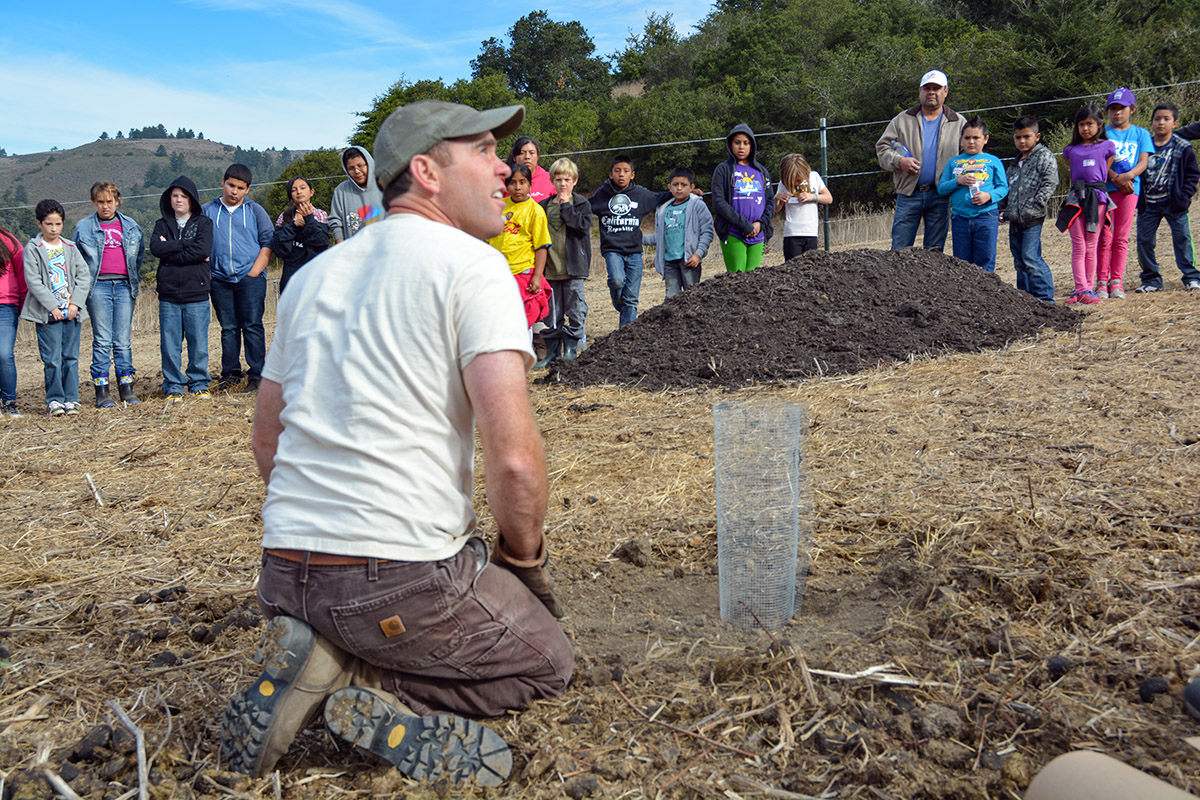It’s springtime at the ranch and everywhere you go the birds are singing! The bird songs are especially noticeable while walking along Honsinger Creek.
The Remarkable Benefits of Riparian Areas

05/03/2022
By: Wendy Millet and Mark Biaggi

 It’s springtime at the ranch and everywhere you go the birds are singing! The bird songs are especially noticeable while walking along Honsinger Creek. The lush riparian areas that grow along the creek are preferred habitat for the many bird species that call the ranch home. On a recent tour with scientists from Point Blue Conservation Science, we listened to the calls of migrating birds from Central America (bird banding from previous years shows us which birds return each year!) and had a chance to reflect on the positive changes we have seen through our management.
It’s springtime at the ranch and everywhere you go the birds are singing! The bird songs are especially noticeable while walking along Honsinger Creek. The lush riparian areas that grow along the creek are preferred habitat for the many bird species that call the ranch home. On a recent tour with scientists from Point Blue Conservation Science, we listened to the calls of migrating birds from Central America (bird banding from previous years shows us which birds return each year!) and had a chance to reflect on the positive changes we have seen through our management.
The benefits of riparian areas go well beyond birds. For thousands of years, elk, bison, deer, antelope, elephant, and a million wildebeest have eaten, drunk and benefited from riparian habitat in our region. As droughts and climate patterns continue to change, riparian areas are increasingly valuable for the well-being of animals, fish, plants, and people alike.
BENEFITS OF RIPARIAN AREAS
Riparian areas serve as a catalyst for the surrounding landscape; their influence spreads across the landscape in a host of ways.
> CARBON
Riparian areas are one of the habitats in our Mediterranean climate that grow year round. As the plants and trees grow they absorb energy from the sun and exude sugars/carbon into the soils thus helping to maintain a healthy microbiome.
> BIODIVERSITY
These areas are high in plant diversity which in turn support a higher function of insect, fish, bird and mammal populations.
> WATER INFILTRATION
When healthy, riparian areas act as a sponge—absorbing and releasing water. The bigger the riparian area, the more protection against flooding; riparian areas also rehydrate the aquifers below.
> FIRE BUFFER
Wide riparian areas can slow or stop wildfires due to high moisture levels in the system.
> RUNOFF (NUTRIENT SINK)
Healthy riparian areas collect mineral and nutrient runoff. Over time, wildlife and grazing animals may consume these nutrients (in the form of plants) and move them back into the landscape (in the form of manure).
> COOLER TEMPERATURES
Riparian areas provide shade that lowers water temperatures and reduces evaporation; the green growing plants absorb energy from the sun (energy sink), lowering local temperatures in and around riparian areas.
> BANK STABILITY
Riparian vegetation provides the greatest benefits when it is wide with a high percent of mature, native trees. Clearing close to streams can lead to bank instability, decreased large woody debris, insufficient shading thus warming water temperatures, and other adverse effects.
HOW WE CARE FOR RIPARIAN AREAS
TomKat Ranch recognizes the importance of riparian areas to ecosystem integrity and function in the watershed and has prioritized efforts to enhance and restore these areas. Fortunately, riparian habitat is incredibly resilient such that even once damaged areas can become functioning riparian ecosystems with a little help. Thanks to these efforts, we now have numerous healthy riparian stands that didn’t exist 10 years ago and will continue to allow these areas to grow and expand.

Point Blue Conservation Science STRAW (Students Restoring a Watershed) project at TomKat Ranch
THE TOOLS WE USE
> PLANTING
Over the last few years, in partnership with Point Blue Conservation Science (Point Blue) and a program called STRAW (Students Restoring a Watershed), we have worked with local students to plant native vegetation along once degraded streambanks. This program is a wonderful way to engage students in caring for their watershed. After several years, the small sprouts that students planted are growing into healthy trees that provide shade and habitat near perennial and seasonal creeks and springs.
> GRAZING
Riparian habitat attracts all kinds of animals and birds because of the shade, water, and healthy vegetation it provides. As such, it is crucial to ensure that livestock impacts are carefully managed to promote, not degrade, ecosystem health. Brief periods of cattle grazing in riparian areas during the dry/ non-breeding season may help maintain understory structure (i.e. reduce dense blackberry patches and stimulate herbaceous plants), smooth bank edges, and promote overall ecosystem health.
> REST
Grazing in riparian areas can impact birds by changing vegetation structure and composition so reducing cattle impacts during the nesting season is recommended. We also keep livestock out of riparian areas after a grazing period so the vegetation has time to regrow. Lastly, we do not trim riparian vegetation where it encroaches into pastures as our goal is to encourage expansion of the riparian forests for all the benefits they provide.
IN CONCLUSION
Well-managed riparian areas offer human and wild communities a remarkable suite of benefits. These diverse and wet environments help sequester carbon, foster biodiversity, improve water quality and quantity, and provide beautiful places for us to enjoy. Caring for riparian areas requires intention, care, and adaptation, but the myriad benefits they provide are well worth the investment. Whether your management plan is focused on climate stability, the well-being of wildlife, resilience to flood/drought, or aesthetic beauty, riparian areas are a priceless resource to steward.